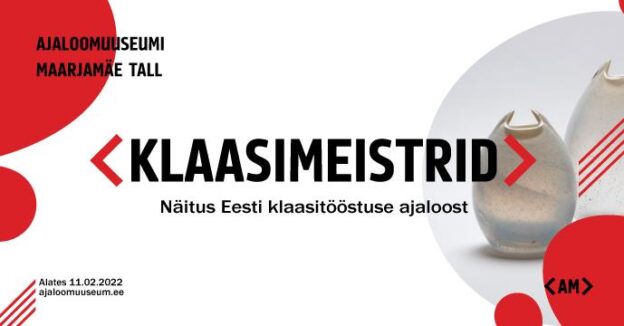11.2.2022 – 31.12.2022
The exhibition “Glass Makers: The History of the Estonian Glass Industry” provides a comprehensive overview of the history of the Estonian glass industry and the most important producers of glass. Visitors can get to know glass in all its beauty – the exhibition begins with the oldest glass objects found in Estonia and ends with today’s glass production.
The exhibition features products from all the most important glass workshops and factories in Estonia, which allows the viewer to notice the technical and artistic development of glass production and see how shiny mirrors and crystal objects are achieved from the initial opaque glass sheets. The extensive exhibition of items is based on the unique collections of the Estonian History Museum, but also includes the finest examples from other museums and private collections. In addition to the exhibited items, it is possible to see unique archive footage that introduces the development of glass production and how glass is produced at the Järvakandi glass factory today.
There are also exciting interactive areas at the exhibition that offer the opportunity to consider the value and properties of glass. Mirrors, adventures in the world of coloured glass, shards of glass – glass is fragile after all. In addition to the perception of glass as a material, the interactive areas offer visitors the opportunity to preserve their likeness in the beauty of glass.
Glass production is the local industry with the longest history. For four centuries, this material with its complex technical and unique physical properties has been produced in almost every corner of Estonia. The production of industrial glass began in 1628 in Hiiumaa in the Hütti glass factory, which belonged to the Swedish landowner Jakob de la Gardie, but by the 18th century similar workshops were being established all over Estonia. The golden age of our glass industry came after the birth of statehood, when factories based on local capital were established and the first Estonian masters were trained. Domestic glass production reached world standards in 1934, when the progressive industrialist Johannes Lorup established a modern factory in Tallinn, where semi-crystal and crystal items were produced for the first time, in addition to glass. After the implementation of the Soviet regime, the Lorup company was nationalised and renamed Tarbeklaas.
Today, the only glass manufacturer in Estonia is the Järvakandi Glass Factory, which mainly produces glass containers.
The exhibition is open in the Maarjamäe stable building of the History Museum from 11th of February 2022.
Exhibition curator: Anne Ruussaar
Design: Anne Määrmann, Kristi Prinzmann, Bob & DokoDoko
Graphic design: Motor
Project team: Krista Sarv, Kärt Kelder, Laura Kipper, Peeter Mauer, Galina Zaitseva, Tiina Sakemaa, Aime Andresson, Riho Ints, Helene Tedre, Ruth Laidvee, Piia Sinisalu, Sigrid Huik and other membes of Estonian History Museum team.
Cooperation partners:
Estonian Museum of Applied Art and Design
Tallinn City Museum
Tartu City Museum
Tallinn University
Järvakandi Glass Museum
Järvakandi Glass Factory
Private collectors – Kalle Kimsto, Epp Eelmaa, Sylvia Kesa, Kalle Oja, Toomas Plaan, Toomas Zupping, Marek Kuul, Ilona Ringas, Silja Põder, Sigrid Huik, Ene Hiio, Salme Jugaste, Maie-Ann Raun
With thanks to:
Järvakandi Glass Factory

